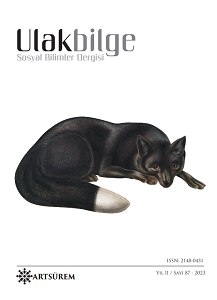ANADOLU SELÇUKLU SANATINDA SARMAŞIK MOTİFİ
IVY MOTIF IN ANATOLIAN SELJUK
Author(s): Remzi Duran, Ayla YılmazSubject(s): Architecture, Communication studies, Islam studies, Sociology of Culture, Sociology of Art
Published by: Sanat ve Dil Araştırmaları Enstitüsü
Keywords: Ivy motif; architectural; Anatolian Seljuk;
Summary/Abstract: Ivy, on old myths and beliefs; It is a plant that has symbolic meanings such as abundance, creation, virtue and reaching the sky. Apart from this, and in the context of the myth of ascension, it acts as a means of communication between earth and sky. Throughout human history, the sky has always been a sacred value in almost all civilizations, myths and beliefs. People have used various means to reach or communicate this value. One of the means used for ascension in myths and religions is the ivy plant. Apart from these deep meanings, the ivy plant appears as a motif in literary and visual arts. Artists were inspired by their own culture and beliefs while choosing the item to adorn their work. Considering the communication power of art, the ivy motif has been examined with the belief that the motifs chosen by the artist as an ornamental element in his works bear traces of his own culture and belief. In particular, we are of the opinion that each of the motifs in ornamental designs, which are defined by general qualifications such as grift and arabesque, should be examined and defined in Turkish Islamic works. The ivy plant has been used as a motif in the works of art by adopting its own decoration understanding of each period. In this study, the Anatolian Seljuk Period, which succeeded in synthesizing pre-Islamic Turkish culture and Turkish-Islamic culture both architecturally and ornamentally, is discussed. The usage areas of the ivy motif as an ornamental element in the works of the Anatolian Seljuk Period have been determined, and the typological design of the motif has been conveyed.
Journal: Ulakbilge Sosyal Bilimler Dergisi
- Issue Year: 11/2023
- Issue No: 87
- Page Range: 708-728
- Page Count: 21
- Language: Turkish

